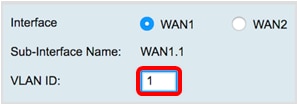Configure Static IP WAN Settings on the RV34x Router
Available Languages
Introduction
A Wide Area Network (WAN) is a network that covers a broad area. A user or network of users can connect to the Internet through an Internet Service Provider (ISP) who offers various methods to set up a client with an Internet connection. These methods can be automatic Dynamic Host Configuration Protocol (DHCP), Static Internet Protocol (IP), Point-to-Point Protocol over Ethernet (PPPoE), Point-to-Point Tunneling Protocol (PPTP), Layer 2 Tunneling Protocol (L2TP), Bridge, and Stateless Address Auto-configuration (SLAAC) for IPv6.
Configuring the right WAN settings on the router is necessary in order to properly set up Internet connection based on your network requirements and setup. Some WAN settings to be used on your router such as Usernames, Passwords, IP addresses, and DNS servers should be provided to you by your ISP.
In this scenario, the setup from the ISP requires the router to use Static IP settings in order to connect to the Internet. This connection type allows you to specifically assign a preferred IP address to a device for a period of time. Static IP is mainly used for device services that do not change IP addresses on the Internet.
Objective
This article aims to show you how to configure the Static IP WAN settings on the RV34x Router.
Applicable Devices
- RV340
- RV340W
- RV345
- RV345P
Software Version
- 1.0.01.17
Configure Static IP WAN Settings
Note: The ISP provides the static IP address and other specific addresses for your connection.
Step 1. Access the router web-based utility and choose WAN > WAN Settings.

Step 2. In the WAN Table, click the Add button.

Step 3. In the Add/Edit WAN Sub-interface window that appears, click on the WAN interface that you want to configure.

Note: In this example, WAN1 is chosen. This is the default setting.
Step 4. Enter the VLAN ID in the field provided. In this example, 1 is used.

Note: The Sub-Interface Name area automatically updates based on the WAN and VLAN ID entered. In this example, WAN1.1 is displayed indicating WAN 1 and VLAN 1.
Step 5. Click the tab of the connection that you are using.

Note: In this example, IPv4 is chosen. This is the default setting. If you are using IPv6, skip to IPv6.
IPv4
Step 6. Click on the Static IP radio button to choose the Connection Type.

Step 7. Under Static IP Settings, enter the static IP address that the router will use in the IP Address field.

Note: In this example, 192.168.2.2 is used.
Step 8. Enter the Netmask in the field provided.

Note: In this example, 255.255.255.0 is used.
Step 9. Enter the Default Gateway in the field provided.

Note: In this example, 192.168.2.0 is used.
Step 10. Enter the Static DNS 1 in the field provided.

Note: In this example, 192.168.2.0 is used.
Step 11. (Optional) Enter the Static DNS 2 in the field provided.

Step 12. Click Apply.

IPv6
Step 1. Click the IPv6 tab.

Step 2. Click on the Static IP radio button to choose the Connection Type.

Step 3. Under Static IP Settings, enter the IPv6 IP Address in the field provided.

Note: In this example, 2001:DB8:0:CD30::123:4567 is used.
Step 4. Enter the Prefix Length in the field provided. This determines the number of bits in the address.

Note: In this example, 64 is used.
Step 5. Enter the IPv6 Default Gateway in the field provided.

Note: In this example, 2001:DB8:0:CD30::123:4566 is used.
Step 6. Enter the Static DNS 1 address in the field provided.

Note: In this example, 2001:DB8:0:CD30::123:4566 is used.
Step 7. (Optional) Enter the Static DNS 2 address in the field provided.

Note: In this example, 2001:DB8:0:CD30::123:4555 is used.
Step 8. (Optional) Check the DHCP-PD checkbox if you are using DHCPv6 prefix delegation.

Step 9. (Optional) Enter the prefix name in the field provided.

Note: In this example, DHCPv6 is used.
Step 10. Click Apply.

You now have successfully set your RV34x Router WAN settings to Static IP.
 Feedback
Feedback